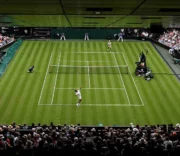
In the world of tennis, players and fans alike have been long familiar with marathon matches that drag on into the early hours. The Australian Open, one of the grand slams, is now taking measures to ease such occurrences. The year 2024 will usher in a new format, promising a slightly relaxed timeline. Here’s everything you need to know about this change.
Why the Change?
Recent years have witnessed a series of prolonged, intense matches at the Australian Open, culminating in late or early morning finishes. Andy Murray’s bout with Thanasi Kokkinakis, which ended at 4:05 a.m., stands out as a memorable instance from the recent tournament. Notably, Murray’s irritation was compounded when he was denied a toilet break mid-match.
The call for a revised schedule isn’t just about the late finishes. The traditional structure – with five major matches daily – has taken a toll on both players and attendees.
The New Australian Open Schedule: At a Glance
- Duration: The tournament will stretch over 15 days instead of the usual 14.
- Starting Dates: The grand slam will commence on January 14 and wrap up on January 28, 2024.
- First-Round Format: The first round will span three days, as opposed to the previous two, easing the congestion during the initial phases.
- Total Sessions: The number of sessions will increase from 47 to 52 across three major arenas.

Historical Late Finishes: A Retrospective
The Murray-Kokkinakis match wasn’t the latest finish the Australian Open has seen. In 2008, a match between Lleyton Hewitt and Marcos Baghdatis concluded at 4:33 a.m., following Roger Federer’s lengthy four and a half hour battle against Janko Tipsarevic.
While these late matches might be a treat for international viewers in regions like Europe and North America, they’re considerably less enjoyable for local spectators and, undoubtedly, the athletes.
Night Caps in Grand Slams: A Comparative Look
The Australian Open isn’t alone in hosting night sessions. Both the French and the US Open follow suit. Wimbledon, on the other hand, imposes an 11 p.m. curfew. This cutoff, introduced in 2009, aims to ensure spectators’ safe return home. However, this curfew has occasionally left fans in suspense, especially during intense matches.
For perspective, consider the longest professional match ever played: the 11-hour duel between John Isner and Nicolas Mahut at Wimbledon in 2010. This battle spanned three days!
Closing Thoughts
Australian Open’s tournament director, Craig Tiley, expressed his enthusiasm for the upcoming changes, noting that the decision arose from feedback from both players and fans. The objective is clear: to offer a more equitable and less demanding schedule.
However, a lingering question remains: How will this revision impact the competitive spirit and the viewing experience? Only time will tell.
Quick Fact
The absence of a time constraint in tennis dictates that a match will continue until one player emerges victoriously. This inherent feature of the sport has led to some of the most iconic, extended clashes in its history.
































